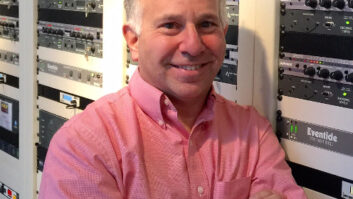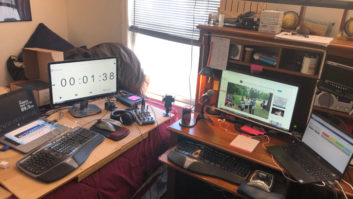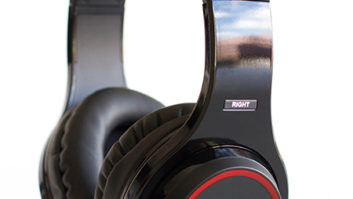Charlie Rohde is an old DFW, Texas, broadcast engineer who’d gotten tired of calls in the middle of the night.
Ten years ago he went to work for BNSF Railroad’s telecom department at its network operations center – only to find that BNSF has one of the largest private telecommunications network in the world. Just one of its many 100 Mbps routers sets it back $250,000. This is data, nationwide two-way, LAN, WAN, video, tracking systems – everything he did in broadcasting, but on a billion-dollar scale.
Charlie does keep up with his first love, broadcasting, though.
After taking a look at an earlier Workbench, Charlie saw that Scott Todd was looking for sources for surface-mount devices as well as a method for their removal. A source for many of these parts is Mouser Electronics in Mansfield, Texas, on the Web at www.mouser.com or at (800) 346-6873. They have an extensive stock of surface-mount components.
Now for a tip on removal and replacement: Use two low-wattage irons on either end of the device, then gently lift the part off. Another choice is a “hot air” pencil iron. The prices on the hot air irons have dropped; they run about $175 or less.
. . .
(click thumbnail)Fig. 1: Safety first. A voltage-sensing pen may save your life.
Put an AC voltage-sensing pen at the top of your list. Joe Soucise, chief at Infinity’s WZLX(FM) in Boston, uses his Fluke pen regularly. In Fig. 1, the device is showing live AC at the circuit breaker on a Continental FM transmitter.
Make it a practice to invest in this little safety tool and run it across the wires you’re ready to dike or the transmitter you’re about to enter. Some years ago, the Texas Association of Broadcasters handed this type of pen to attendees at its state convention. If your SBE treasury permits it, how about investing in these pens? Pass them out to members who attend regular meetings. Who knows? The investment may just save a life.

. . .
Gary Liebisch and Dave Agnew are Harris radio application engineers for the company’s AM and FM product line. There’s a lot of experience between the two. Give them a call if you have an applications question on Harris transmitter products.
After reminding readers of the need to replace memory-backup batteries, I mentioned that these batteries are found in most solid-state transmitters. Gary wrote to correct me; the new Harris AM DAX transmitter stores operational parameters in non-volatile EEPROM, so a battery is not needed. Thanks for the clarification, Gary.
Liebisch is at [email protected].
. . .
William Weisinger runs William Weisinger Engineering Services, based in the Akron/Cleveland market. Bill confirms that many Sage Endec EAS units are nearing the end of the their time/date battery lives.
A proactive replacement stance is wise. In Bill’s case he needed to pop the hood on them anyway to replace old PROM ICs with the new version.
In checking the manual, Bill found that the replacement battery is a CR-2330. This is a 265 mAh, 23.0 x 3.0 (mm), 3 volt lithium battery. No problem, right? Guess again; not a single CR-2330 was to be found, not even at the local Radio Shack store, which had them as mail-order only and cost $3.99. Even Harris was out when he called.
A CR-2320 would fit, but with 120 mAh, it wouldn’t go the same distance. A BR-2330 looked good, but none of those could be found either.
What’s the bottom line? Bill found and ordered several batteries from Mouser Electronics. It’s their part number #658-CR2330. They cost $1.57 each plus UPS shipping, and they arrived in a few days. Thanks, Bill, for the advice.
For clusters of stations, get these batteries ordered and replaced. It’s also advisable to stick a little note on the Endec’s top with the date the battery was replaced, and where you ordered it. It will save you a headache next time a replacement is due.
. . .
Bill Weisinger’s company has a neat Web site, www.wwes.org On the site, Bill describes several products he manufactures that solve typical broadcast problems.
(click thumbnail)Fig. 2: This inexpensive switch box controls AC devices.
The AM/FM Skimmer/Receiver/Recorder is just what your PD wants to order. It’s a full-featured skimmer (adjustable off and skim times), and it doesn’t use a wall-wart power supply.
Looking for an inexpensive way to reboot your studio computer? The AC Remote Relay Box provides wired remote control of any 115 VAC device, seen in Fig. 2. The entire assembly is housed in a dual AC duplex box, with mounting tabs and two active AC outlets. The relay can be set for normally open or normally closed operation. Operation of the Remote Relay Box is via low-voltage DC control pair, with the control voltage generated inside the box; no external supply is needed. The AC Remote Relay Box costs $89.95 plus shipping and handling.
Weisinger can be reached at [email protected].

. . .
(click thumbnail)Fig. 3: You have a freshly stocked first aid kit at your transmitter site … don’t you?
When was the last time you checked the supplies in your first aid kit? Do you even have a first aid kit, like the one in Fig. 3, at your transmitter sites?
If you have ever needed first aid supplies, you’ll agree a kit is the best investment you could make. One of the most common mistakes, though, is not replenishing supplies. Next transmitter visit, open your kit and see what’s missing.
Submissions for this column are encouraged, and qualify for SBE recertification credit.













